Early Literacy Aside--Empower: We can help children learn new words as we play with them. In today's storytime we read We're Going on a Bear Hunt which had directional words. Here is a game you can play. Show your child an item (a shoe perhaps) and hide it in a room with a little of it showing. Give your child hints about where to find it using position words like right, left, above, below, and so on. You can also give clues like, "You're getting warmer or colder" as they get closer or farther away. Here is a handout with the game and some activities to support pre-reading skills.
Hickory Dickory Dock with Handout
You can use the figures on the handout as a pattern to make a flannel board. Then use the flannel board as another way to share the rhyme and to play a game.
Introduction: Let's say the rhyme Hickory Dickory Dock Hickory dickory dock The mouse ran up the clock The clock struck one, the mouse ran down. Hickory dickory dock. Repeat using struck two . . . the mouse said "Boo." struck three . . . the mouse said "Whee." struck four . . . the mouse said "No more!" Great! Now let's play a little game on the flannel board. I am going to put the mouse somewhere near the clock and you see if you can tell me where. [Put the mouse on top of the clock.] Where is the mouse? Right! On top of the clock. Repeat with behind, underneath, below, beside or next to, etc.
Early Literacy Aside--Example: When we use words that describe position, you are helping your children understand what the words mean. This will later help them understand what they read. Early Literacy Aside--Empower: Adults, I have a handout here with illustrations for Hickory Dickory Dock. In addition to saying the rhyme together with your children, you can cut out the figures and put the figures in different positions to help your children learn new words and build their vocabulary. Enjoy!
A Rhyming We Will Go
Early Literacy Aside--Example: Let's take an interesting word from this book we just read. [Choose a word.] Now we'll play this song game. Helping your children make rhymes or notice words that rhyme is one way to help them hear the smaller sounds in words which will help them later to sound out words.Song to the tune of A Hunting We Will Go A rhyming we will go A rhyming we will go We’ll catch a rhyme In the nick of time And this is how it goes.
I caught the word _____! What rhymes with ______? Good, what else rhymes with _____?
Repeat as often as you like. Rhyming words can be nonsense words!
Early Literacy Aside--Empower: Remember the rhyming song game we played earlier? You can play this little game any place, any time you are with your children--in the car, waiting in line, at the doctor's office. These little things you do all add up to make a difference in helping your child be ready to learn to read. When you help them hear and make rhymes, you are helping your child develop phonological awareness, hearing the smaller sounds in words so they can later sound out words when they learn to read.
ABC Look at Me by Roberta Intrater
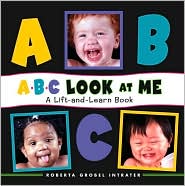
Early Literacy Aside: Explain Aside: Noticing that the same letter can look different, like upper and lower case, is a beginning step for letter knowledge, one of the early literacy skills that children need to be able to learn to read.
Early Literacy Aside--Example Aside: One way we can help children learn what the letters look like and the letter names is by sharing alphabet books. When sharing alphabet books with children, we tend to focus more on the print than with any other type of book. Let’s share an alphabet book together.
Share the book ABC Look at Me by Roberta Intrater. Did you notice that when I read the book, I pointed to the letter? As we read alphabet books, we tend to point out the letter on the page as we say its name. This does not come so naturally while reading other kinds of books. As you talk about the letter you can point out that the same letter can look different. For example, here’s the letter R. It can look like R or r.
Empower Aside: When you read alphabet books, don’t worry if your child does not recognize the letters and the different ways they look. You are just introducing the idea that the same letter can look different. Alphabet books do not need to be read from A to Z. You can give the book to your child and let them choose a page that looks interesting. Then talk about the picture and the letter. As your child grows, keep pointing out and talking about letters. Let your child see your interest in them and they will follow your lead in learning them.
Sound in a Bag/Box
Preparation: Put some items in a bag or box, some of which starting with the sound /p/ (for example). Some examples include: pretzel, popcorn, paper, pig. Also include some items for words that do NOT begin with /p/.
Introduction: Ohhhh, here is my sound bag/box. Let’s see what’s in it today. Our llama in the book we just read was wearing red pajamas (Llama, Llama Red Pajama by Anna Dewdney). Pajama starts with the sound /p/. Let me hear you say /p/. Good! I am going to pull out different things from my sound box. Let’s see which ones have the same beginning sound as pajama, /p/.
Play Game: As you pull items out of the bag, say what it is; or ask the children what it is. Repeat the word and emphasize the first sound. Our next item is a car. Car. Car. Car starts with /k/. Are /k/ and /p/ the same sound? That’s right! They are not. Let’s look for our next item. What else do I have in here? What is this? Right, a pencil. Pencil. Pencil. Pencil starts with /p/. Do pencil and pajama sound alike at the beginning? Yes, they do!
Early Literacy Aside--Example Aside: Helping your child hear the beginning sounds of words, in a playful way, like with this game, is one way that you can help your child develop [phonological awareness,] hearing the smaller sounds in words.
Early Literacy Aside--Empower Aside: We played the sound in a bag game today. You can play this game with any items you have around the house. Or you can have a sound day--today is /d/ day. Throughout the day you and your children look for or think of words that start with the /d/ sound. Remember, you're not thinking about how a word is spelled, just the beginning sound. Keep it fun, not frustrating. This game is one way to help your children later sound out words when they learn to read.
Hush, A Thai Lullaby by Mingfong Ho
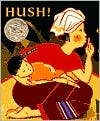
Early Literacy Aside--Explain: Today our early literacy tip is on hearing the smaller sounds in words. This pre-reading skill will help children later sound out words when they learn to read. [The skill is called phonological awareness.] I'll be pointing out some activities you can do to support this skill as you read with your children.
Introduction:Hush: A Thai Lullaby by Mingfong Ho is our next book. It is about a mother in Thailand singing a lullaby to her baby.
Early Literacy Aside--Example: This book has both animal sounds and rhyming words. Both of these activities, hearing and saying animal sounds and hearing and saying rhyming sounds and words support one of the early literacy skills, phonological awareness.
Read the book. Have participants join in with saying the sounds of the animals. After you read the book, come back to a page and talk about two words that rhyme. Have the children think of other words that rhyme--remember they can be nonsense words.
Early Literacy Aside--Empower: Today I pointed out some activities around the early literacy skill phonological awareness: hearing different sounds such as animal sounds, as we just did and having children make those sounds. For older children, we want them to be able to hear the smaller sounds in words, the syllables, to be able to hear and make the beginning sound in a word, to be able to hear and make rhyming words, and to play with these sounds. Researchers know these are important skills for later when your child tries to sound out words. Children develop at different stages and some things will be harder for some and easier for others. It is easier to recognize a rhyme than to make a rhyme, so if your child cannot rhyme a word, say two words and ask if they rhyme. By doing these activities, you will be helping your child enter school ready to learn to read.
Shapes Flannel Board and Matching Game
Preparation for Presenter: Using cutouts of different shapes (see attachment below) make shapes you can use on the flannel board. If you want to play the matching game in addition to talking about shapes, make more than one of each shape.
Introduction: Today we talked about shapes and alike and different. So let’s see what shapes you see up here. Depending on the size, age-level and attention span of the group, you can put the shapes up yourself or hand them out to the toddlers and have them put the shapes up on the flannel board. Say the name of the shape as well as some additional description. For example, "Here is a circle, a small blue circle.” Have the children repeat the name of the shape and/or the description.]
Early Literacy Aside--Example: Helping your child notice and talk about shapes later helps them identify letters. When you think of an upper case A, there is a triangle shape in it. For Matching Game: You keep one copy of each shape and pass out the additional copies of the shapes. Put up one shape, say what it is and describe it. Then have those children who have the same shape come up to the flannel board to add theirs to yours. Don't forget to clap for each person. Adults are welcome to help their children.
Early Literacy Aside--Example: Playing matching games helps your child notice what is alike and different. This is one part of developing letter knowledge.
Matching Game Variation: You can make the matching more challenging by making patterns on your shapes. For example, you may color a couple of circles on a square, or make a design on two copies of the same shape. You can make the matching more or less challenging by how intricate or obvious the differences are. Use the handout of shapes for parents and children to cut out and play with at home. Early Literacy Aside for Shape Handout--Empower: This handout has several shapes you can cut out at home. You can use them as patterns and cut them out of different color paper. You can draw on them to make different patterns to match as well. You might ask your toddler to put all the circles together, all the ones with straight lines, all the ones with the same color. Sorting is one way of noticing what is alike and different. When children try to recognize letters they will need this skill. Think of a lower case h and a lower case n. They look similar but they are also different.
My First ABC Board Book (DK)
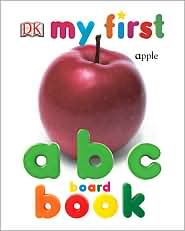
Early Literacy Aside--Example: Sharing alphabet books is one way to introduce children to letters. This book My First ABC Board Book has bright, clear photographs of things that interest young children.
Share a page or two: For example, on the B page, we see a baby, bananas, a ball, and bread. We see both the upper and lower case letter so children see that the same letter can look different. You can give the book to your child and let him choose a page to talk about. Talk about the pictures and point out the letter.
Early Literacy Aside--Empower: Naming the letters and pointing to them is a first step to developing your child's letter knowledge, one of the six early literacy skills. You can do this with books and also with signs whenever you are out and about. Remember to keep it enjoyable and stop when your child has had enough. No need to quiz your child on the letters, just expose them to the letters.
Color Zoo by Lois Ehlert
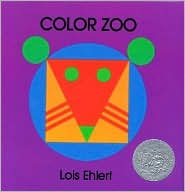
Early Literacy Aside--Explain: The beginning of letter knowledge, one of the six early literacy skills, is seeing and recognizing shapes. Researchers have found that children learn to recognize letters by their shapes. I'll be pointing out some ways that you can use books to talk about shapes.
Early Literacy Aside--Example: Our next book is Color Zoo by Lois Ehlert. It is really fascinating how you can see the animals just using basic shapes. What animals do you see? Sharing books with stark shapes like this is a first step to recognizing letters later. Read the book. Talk about the shapes as well as the animals. The back of the book are the separate shapes which you can also point out or refer to from time to time as you read the book.
Early Literacy Aside--Empower: This is quite a sophisticated book and can be used in many ways with very young children and also as your children get older. Start with simply noticing shapes and bright colors and your older children can make animals from shapes themselves.
Dear Zoo by Rod Campbell
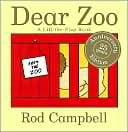
Introduction: I'd like to share this book with you called Dear Zoo by Rod Campbell. It can be tricky to use with little hands. Sometimes children tear the flaps because they don't have good coordination yet. They do like flap books because they can play with the book and it's a kind of peek-a-boo game.
Early Literacy Aside--Example: This simple story has signs which supports the early literacy skill called print awareness, helping your child understand that print has meaning. Pointing to the words on the signs as you read the book helps children understand that these are the words we are saying.
Read book. Point to the words in the signs as you read.
Early Literacy Aside--Empower: As you go around your day, point out signs to your children. Even when your children notice logos like on gas stations, stores, or restaurants, this is the beginning of print awareness.
Adult/Child Animal Flannel Board
Introduction: Our next activity is with animals and what they are called. Baby animals are often called something different from the adult animal. This activity helps your children learn these words.[Put up adult and baby animal figures as you say their names, having children repeat them with you. If you like you can pass out the baby animals to each child. You put up the adult animal and the child puts up the matching baby animal as you say the name of it. Have children repeat the words for both adult and baby animals. Encourage adult to help if needed.]
Early Literacy Aside--Example: Saying the words for both the adult and baby animals helps to develop your children’s vocabulary.
Early Literacy Aside--Empower: Today you saw how we can expand children's vocabulary by giving specific names to things. We did it with animals. You can do the same with the vehicles you see all around you. If your child is calling everything that goes a car, you can say, yes, that’s a car, that’s an SUV, that’s a van, that’s a pick-up truck, and so forth. Even if they can’t say all these words, hearing you say them is how they begin to learn these words. You can also add description, like that shiny yellow car with silver hubcaps. These little things you do throughout the day in enjoyable ways all build your child's vocabulary which later helps them understand what they read.
Fire Truck by Peter Sis
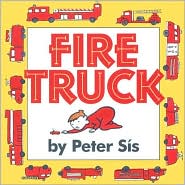
Introduction: This book Fire Truck, written and illustrated by Peter Sis, has lots of interesting words in it.
Early Literacy Aside--Example: Listen to the many different words your child is hearing, words we might be using in everyday conversation. Because books have three times as many rare words as we use in conversation, it is important for children to hear the language of books. As I'm reading this book, just hold up a finger when you hear a word you would not be using everyday when talking with your child. Then we'll see how many you heard at the end of the book.
Read the book. Ask how many words they heard that they would not use in conversation with their children.
Early Literacy Aside--Empower: As you read books at home with your children, you may notice some words they are not familiar with. You don't have to explain every unfamiliar word, but you might choose one to point out and explain. Don't replace unfamiliar words, or they won't hear them. This is how you help their vocabularies grow!
I'm Taking a Trip on My Train by Shirley Neitzel

Introduce book: This book about a train uses pictures for for some words. You can help me by filling in the words when you see the picture.Read book: As you read the book, point to the pictures in the text so that the participants (children and adults) will chime in with the appropriate words.
Early Literacy Aside--Example: (Print Awareness) As you point to the pictures and have children say the words, you are helping them see that pictures represent words. This is the beginning to helping them understand that the written word also represents the words we say. Print awareness is one of the skills children need to be able to learn to read and you are helping to develop this skill when you point to pictures and words as you say words.
Early Literacy Aside--Empower: (for Print Awareness) Having words as part of the text of the story is a fun way to write stories with your child. As your child tells you a story, you can write it down and let them draw pictures for some of the repeated words. They see the written words for their spoken words which develops print awareness.
Early Literacy Aside--Example: (for Narrative Skills) Having your young children chime in with a word or phrase, as much as they can remember, is a first step to being able to retell the whole story. Retelling stories helps children develop narrative skills which later helps them understand what they read.
Early Literacy Aside--Empower: (Narrative Skills) This is a cumulative story, where the lines are repeated. Having your child say the repeated phrases helps to develop retelling the story which develops their narrative skills, one of the skills that helps with later reading. Retelling stories helps develop their understanding of the story as well.
Choose only one skill to highlight (to say the aside).
A Truck Goes Rattley-Bumpa by Jonathan London
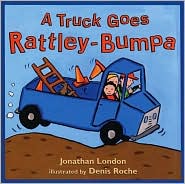
Read book.Say: Some of the pictures in this book have words on the trucks or on signs. Let's see what they say. Choose a page or two with some signs such as MILK or ICE CREAM or MOVERS and point to the words as you say them.
Early Literacy Aside--Empower: In the book A Truck Goes Rattley-Bumpa, I pointed out the words in the pictures you help develop print awareness. When you are out and about, be sure to point out words as you talk about the signs you see all around you.
Now Matter What by Emma Dodd
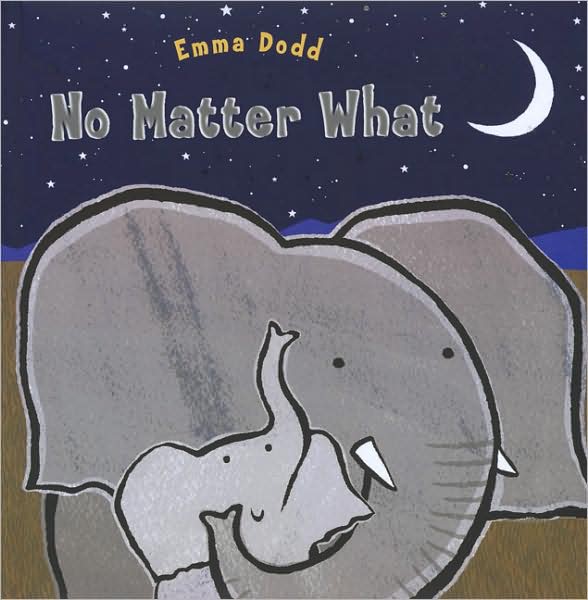 Earlly Literacy Aside--Explain: Welcome. Today we are going to have stories that have elephants in them. [Show elephant puppet] I am also going to highlight vocabulary as a fun way to help your child get ready to read. The more words they know, the easier it will be for them to understand what they read and also to make sense of words as they sound out words.Early Literacy Aside--Example: Very young children learn the names of things they see or see pictures of, like elephant, flowers, mouse. As they get older they understand words for feelings and concepts like sad, happy, good, bad, big elephant, little elephant. And older still, they understand words for ideas like brave, kind, mean. These are examples of ways you can develop your child's vocabulary daily in a fun way. You can use books to help develop all levels of vocabulary. Listen to some of the words as I read our next book.
Read No Matter What
Early Literacy Aside--Empower: The library has many books with opposites, feelings, and other concepts to help you have fun with vocabulary development with your child. Books from naming items to talking about ideas. Just ask us for some suggestions.
Earlly Literacy Aside--Explain: Welcome. Today we are going to have stories that have elephants in them. [Show elephant puppet] I am also going to highlight vocabulary as a fun way to help your child get ready to read. The more words they know, the easier it will be for them to understand what they read and also to make sense of words as they sound out words.Early Literacy Aside--Example: Very young children learn the names of things they see or see pictures of, like elephant, flowers, mouse. As they get older they understand words for feelings and concepts like sad, happy, good, bad, big elephant, little elephant. And older still, they understand words for ideas like brave, kind, mean. These are examples of ways you can develop your child's vocabulary daily in a fun way. You can use books to help develop all levels of vocabulary. Listen to some of the words as I read our next book.
Read No Matter What
Early Literacy Aside--Empower: The library has many books with opposites, feelings, and other concepts to help you have fun with vocabulary development with your child. Books from naming items to talking about ideas. Just ask us for some suggestions.
Submitted by Jeanenne Robinson, Public Library of Charlotte and Mechlenburg County (NC)
Cock-a-Moo-Moo by Juliet Dallas-Conte
 Early Literacy Aside--Explain: Hello, parents. Today in storytime we are highlighting one of the early literacy skills, phonological awareness. This is the ability to hear and play with the smaller sounds in words including rhyming, beginning sounds and today we'll be doing animal sounds. Developing this skill will help children later sound out words as they learn to read.As you read Cock-a-Moo-Moo, note when the rooster crows that the font is large which means to use a LOUD voice. Point out the words for the corresponding sounds. Conclude the story by having the children say cock-a-doodle-do loudly to convey the rooster getting it right.
Early Literacy Aside--Example: Hearing and learning animal sounds helps children hear the smaller sounds in words too.
Early Literacy Aside--Empower: Hearing the rhythm of language and making the sounds of animals, both of these contribute to phonological awareness, hearing the smaller sounds in words, one of the skills that researchers have found helps with reading later on. Take opportunities during the course of the day to point out and to imitate sounds you hear, a car horn, the doorbell ringing, and so forth.
Early Literacy Aside--Explain: Hello, parents. Today in storytime we are highlighting one of the early literacy skills, phonological awareness. This is the ability to hear and play with the smaller sounds in words including rhyming, beginning sounds and today we'll be doing animal sounds. Developing this skill will help children later sound out words as they learn to read.As you read Cock-a-Moo-Moo, note when the rooster crows that the font is large which means to use a LOUD voice. Point out the words for the corresponding sounds. Conclude the story by having the children say cock-a-doodle-do loudly to convey the rooster getting it right.
Early Literacy Aside--Example: Hearing and learning animal sounds helps children hear the smaller sounds in words too.
Early Literacy Aside--Empower: Hearing the rhythm of language and making the sounds of animals, both of these contribute to phonological awareness, hearing the smaller sounds in words, one of the skills that researchers have found helps with reading later on. Take opportunities during the course of the day to point out and to imitate sounds you hear, a car horn, the doorbell ringing, and so forth.
Submitted by Mona Ferguson, Public Library of Charlotte and Mechlenburg County (NC)
Dog's Day by Jane Cabrera
 Read Dog's Day. As you point to the title also point out the letter D in Dog and Day.Early Literacy Aside--Example: Help your children find letters based on the subjects they like. D is the first letter in dog. If your child is interest in trucks, you can point out the letter t.
Early Literacy Aside--Empower: Remember that letters are everywhere! Have your child make letters with their fingers, whole body, or playdough.
Read Dog's Day. As you point to the title also point out the letter D in Dog and Day.Early Literacy Aside--Example: Help your children find letters based on the subjects they like. D is the first letter in dog. If your child is interest in trucks, you can point out the letter t.
Early Literacy Aside--Empower: Remember that letters are everywhere! Have your child make letters with their fingers, whole body, or playdough.
Submitted by Emily Leachman, Public Library of Charlotte and Mechlenburg County (NC)
Pigeon books by Mo Willems
 Early Literacy Aside--Explain: Print motivation is an interest in and enjoyment of books and reading. It is one of the early literacy skills that researchers say are important for children to have before they learn to read. Choose books that you enjoy. Your child picks up on your feelings and understands the enjoyment of books and reading.Read several of the "pigeon" books during the storytime, having fun with them in different ways: acting them out, predicting outcomes, singing "The Pigeon on the Bus" to the tune of "The Wheels on the Bus", drawing a pigeon, etc.
Early Literacy Aside--Example: Parents, you can see we are building on the book to add to the enjoyment of sharing the book itself. You know your child best and you can use your child's interests to build on the books you read together.
Early Literacy Aside--Empower: You may not realize it but by sharing books you and your child enjoy, you are helping to develop your child's print motivation. So, every day continue to share books that you enjoy with your child.
Early Literacy Aside--Explain: Print motivation is an interest in and enjoyment of books and reading. It is one of the early literacy skills that researchers say are important for children to have before they learn to read. Choose books that you enjoy. Your child picks up on your feelings and understands the enjoyment of books and reading.Read several of the "pigeon" books during the storytime, having fun with them in different ways: acting them out, predicting outcomes, singing "The Pigeon on the Bus" to the tune of "The Wheels on the Bus", drawing a pigeon, etc.
Early Literacy Aside--Example: Parents, you can see we are building on the book to add to the enjoyment of sharing the book itself. You know your child best and you can use your child's interests to build on the books you read together.
Early Literacy Aside--Empower: You may not realize it but by sharing books you and your child enjoy, you are helping to develop your child's print motivation. So, every day continue to share books that you enjoy with your child.
Submitted by Susan Blombert, Sugar Creek Branch, Public Library of Charlotte and Mechlenburg County (NC)
Down by the Cool of the Pool by Tony Milton
 Early Literacy Aside--Explain: Researchers have noted one of the areas of early literacy to be print motivation. This means having an interest in and enjoying books. Children are more likely to have print otivation when they are involved with the story. As I share books today, you'll see different ways you can keep your children interested as you read with them.Read Down by the Cool of the Pool
Early Literacy Aside--Example: Having a child say a repeated phrase with you throughout the book keeps him involved and it's an easy way to you to support print motivation.
Early Literacy Aside--Empower: Remember that promoting literacy does not mean creating a school-like setting in your home, but rather taking advantage of the opportunities in your everyday life.
Submitted by Emily Little, Public Library of Charlotte and Mechlenburg County (NC)
Early Literacy Aside--Explain: Researchers have noted one of the areas of early literacy to be print motivation. This means having an interest in and enjoying books. Children are more likely to have print otivation when they are involved with the story. As I share books today, you'll see different ways you can keep your children interested as you read with them.Read Down by the Cool of the Pool
Early Literacy Aside--Example: Having a child say a repeated phrase with you throughout the book keeps him involved and it's an easy way to you to support print motivation.
Early Literacy Aside--Empower: Remember that promoting literacy does not mean creating a school-like setting in your home, but rather taking advantage of the opportunities in your everyday life.
Submitted by Emily Little, Public Library of Charlotte and Mechlenburg County (NC)
Mama Cat Has Three Kittens by Denise Fleming
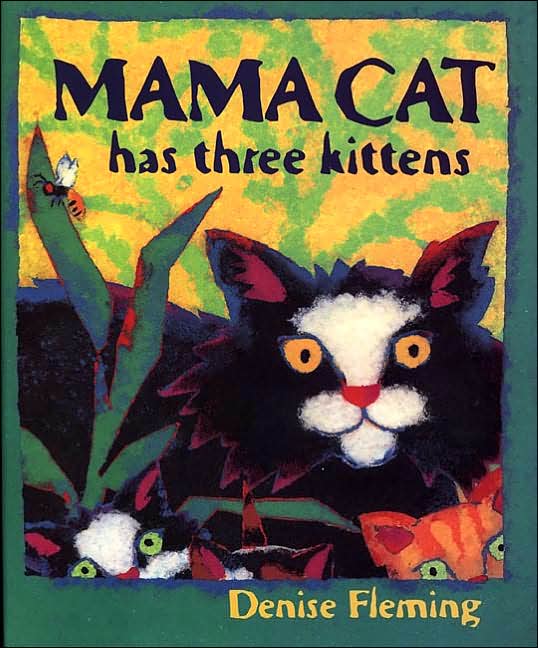 Cat Puppet: There's a cat in my hat, a cat in my hat, a cat in my hat today (do twice). What does the kitty cat say? [cat puppet says meow]Read Mama Cat Has Three Kittens
Early Literacy Aside--Example: When children hear rhymes, rhythms and sounds of animals, it helps them develop phonological awareness, hearing the smaller sounds in words. This is a skill that will help them as they begin to read.
Early Literacy Aside--Empower: Keep doing rhymes with things in your children's world. Today we did cat in my hat. You can do ball in the hall or star on my car (give a star sticker).
Cat Puppet: There's a cat in my hat, a cat in my hat, a cat in my hat today (do twice). What does the kitty cat say? [cat puppet says meow]Read Mama Cat Has Three Kittens
Early Literacy Aside--Example: When children hear rhymes, rhythms and sounds of animals, it helps them develop phonological awareness, hearing the smaller sounds in words. This is a skill that will help them as they begin to read.
Early Literacy Aside--Empower: Keep doing rhymes with things in your children's world. Today we did cat in my hat. You can do ball in the hall or star on my car (give a star sticker).
Submitted by Cathy Cartedge, Public Library of Charlotte and Mechlenburg County (NC)
